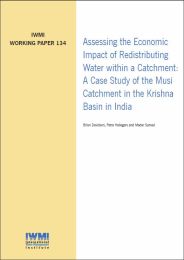Assessing the Economic Impact of Redistributing Water within a Catchment: A Case Study of the Musi Catchment in the Krishna Basin in India.
Citation:
Davidson, B.; Hellegers, P.; Samad, M. 2009. Assessing the economic impact of redistributing water within a catchment: A case study of the Musi catchment in the Krishna Basin in India. Colombo, Sri Lanka: International Water Management Institute. 46p. (IWMI Working Paper 134)
Abstract
The aim in this paper was to present the details of an economic modeling exercise conducted on the Musi Catchment of the Krishna Basin. The model has the unique characteristic of being able to value the water used on individual crops and in different regions. Thus, the individual values of water used to produce different crops, grown over two different seasons and over five very different regions within a catchment, were determined. This is a significant improvement over previous attempts, where a single value of water in a catchment was derived regardless of what it is used for, when it was used and where it used in the catchment. In addition to the agricultural valuation process, some account was made for the other uses of water and how they should be valued. The worth of these findings cannot be underestimated as the results are useful to those who need to allocate scarce water supplies between competing uses within a catchment. The assumptions underlying the model, the data used and the results and implications drawn are fully detailed in this paper. This model was connected to a hydrological model and used to simulate various scenarios on the water situation facing users in the basin. This model is the forerunner of similar modeling attempts on similar problems in other regions of the Krishna Basin and in the Murray Darling Basin of Australia.


